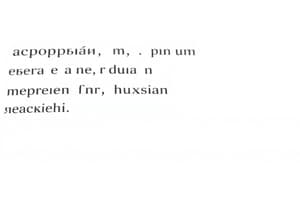Podcast
Questions and Answers
What is the primary distinction of a dialect compared to a vernacular?
What is the primary distinction of a dialect compared to a vernacular?
- A dialect is a formal language established by norms, while vernacular is not.
- A dialect is used in a larger territory and has more features than vernacular. (correct)
- A dialect is a modern version of a language, whereas vernacular is archaic.
- A dialect is characterized by distinctive features observable in local usage. (correct)
Which language served as the foundation for the Romance languages?
Which language served as the foundation for the Romance languages?
- Vernacular Latin
- Classical Latin
- Vulgar/Popular Latin (correct)
- Common Romanian
What defines Literary Language in contrast to Common Romanian?
What defines Literary Language in contrast to Common Romanian?
- It is the refined form formalized in writing versus a spoken historical stage. (correct)
- It exclusively consists of archaic terminologies and vocabulary.
- It retains all dialectal features while Common Romanian does not.
- It is the spoken language lacking any formalization.
What is the significance of the Cyrillic Alphabet in Romanian history?
What is the significance of the Cyrillic Alphabet in Romanian history?
How does Common Romanian differ from southern Romanian dialects?
How does Common Romanian differ from southern Romanian dialects?
Study Notes
Cyrillic Alphabet
- The Cyrillic Alphabet was used to write Slavic languages.
- It was created by Cyril and Methodius in the 9th century.
- It was used in Romania until around 1860.
Dialect
- A territorial variety of a language.
- Characterized by distinctive features (phonetics, vocabulary, grammar, etc.) that distinguish it from the common language of the entire population.
Vernacular
- A territorial variety of a language of a lower rank than a dialect.
- Subordinate to a dialect.
- Used in a restricted territory.
- Characterized by a limited number of linguistic features.
Vulgar/Popular Latin
- An Italic language spoken by the majority of the middle class in the Roman Empire.
- It differed from Classical Latin used by the elite in grammar, vocabulary, and pronunciation.
- It formed the basis of the Romance languages.
Literary Language
- The most refined form of a language spoken by a people.
- Established by norms and formalized in writing.
Common Romanian
- A stage in the Romanian language before the emergence of southern Romanian dialects: Aromanian, Megleno-Romanian, and Istro-Romanian.
- Existed approximately from the 7th to the 10th centuries.
Romanian Language
- According to the linguist Al. Rosetti, Romanian is the uninterrupted Latin language spoken in the eastern part of the Roman Empire.
- This includes the Danube provinces (Dacia, Pannonia, southern Dardania, Moesia Superior and Inferioară).
- The language has been spoken in these provinces since the time Latin entered them until the present day.
Studying That Suits You
Use AI to generate personalized quizzes and flashcards to suit your learning preferences.
Related Documents
Description
Explore the Cyrillic alphabet's history and its role in writing Slavic languages. This quiz also examines dialects, vernaculars, and the evolution of vulgar Latin into Romance languages. Test your knowledge of linguistic variations and their characteristics.





